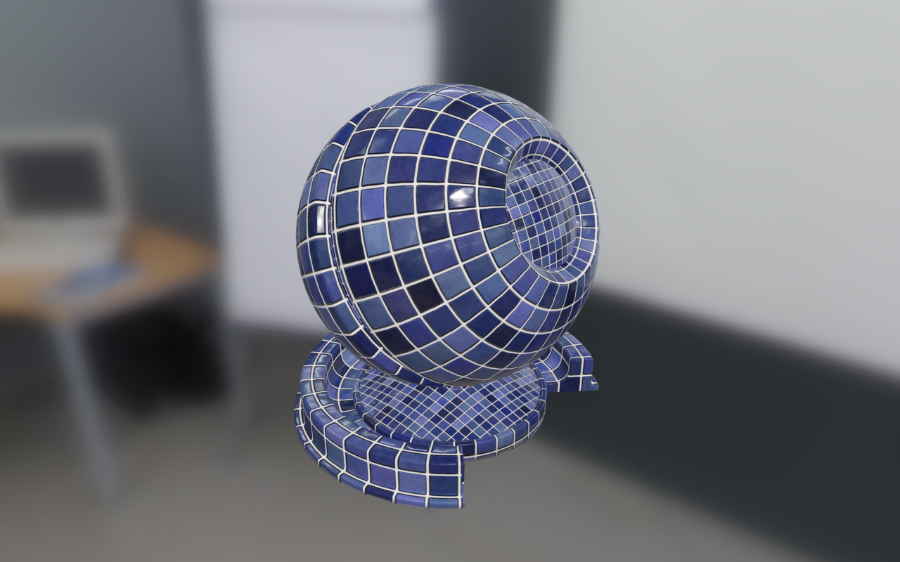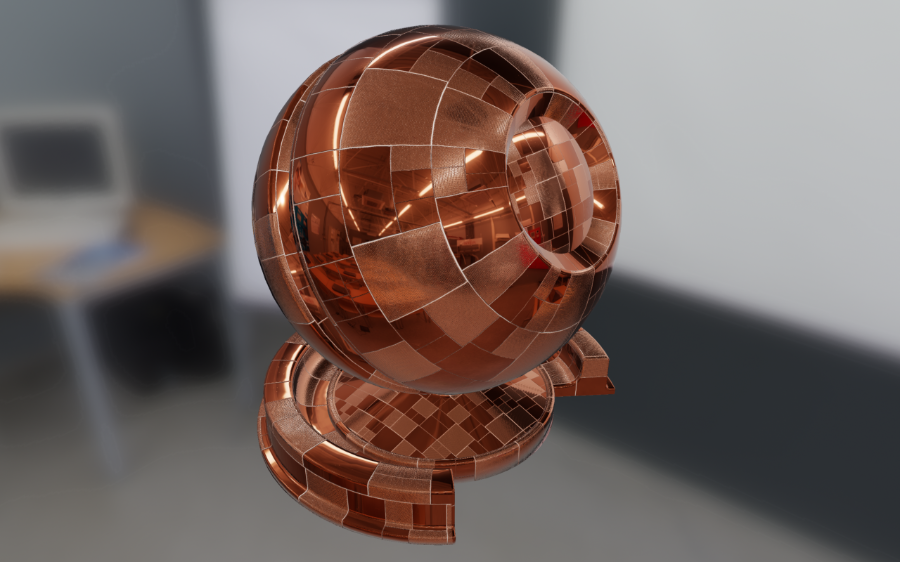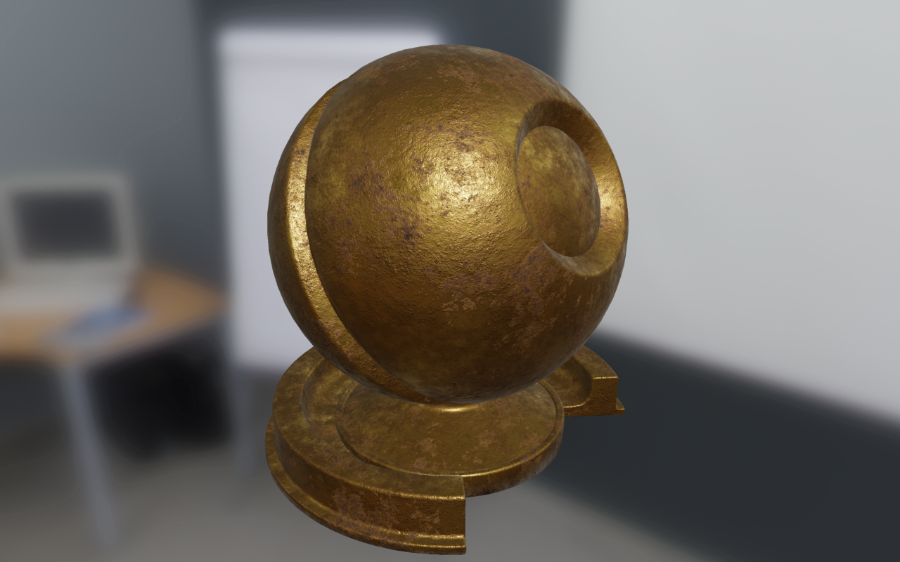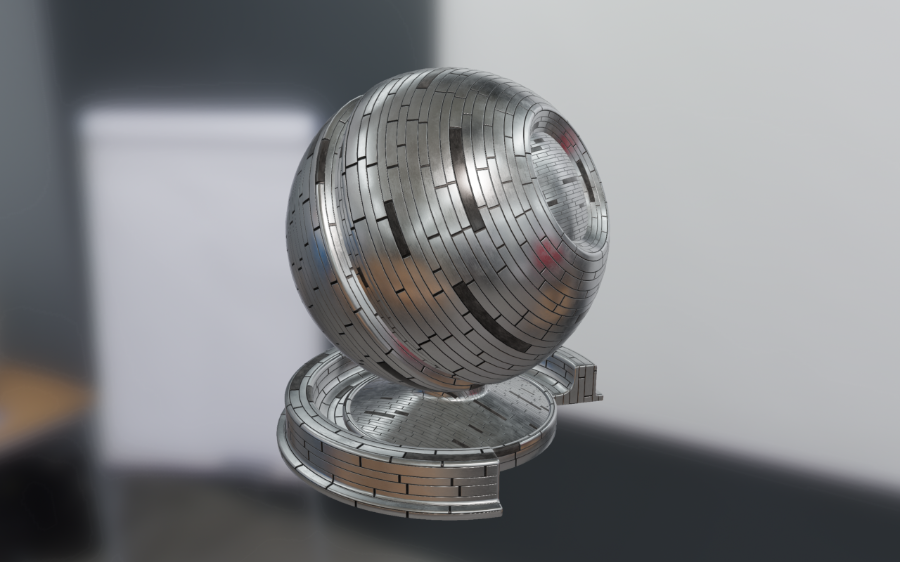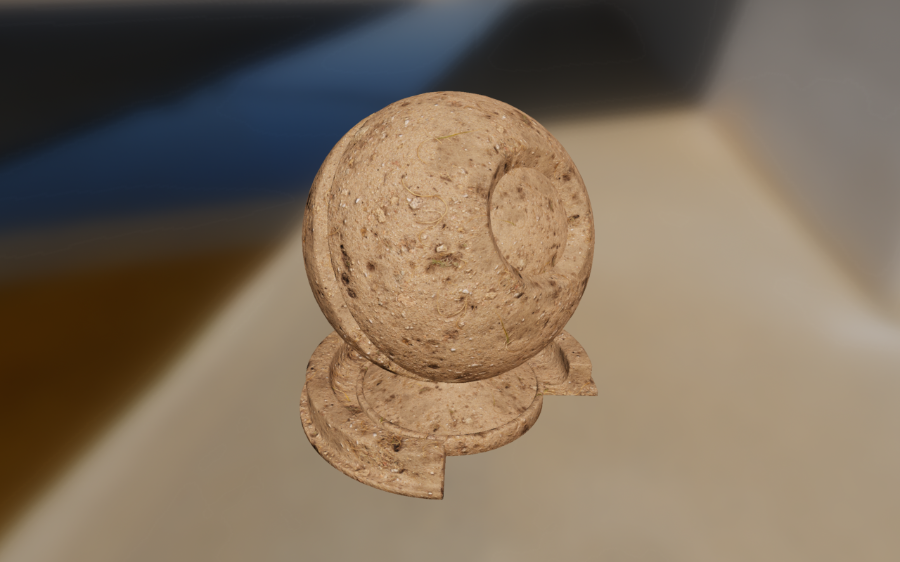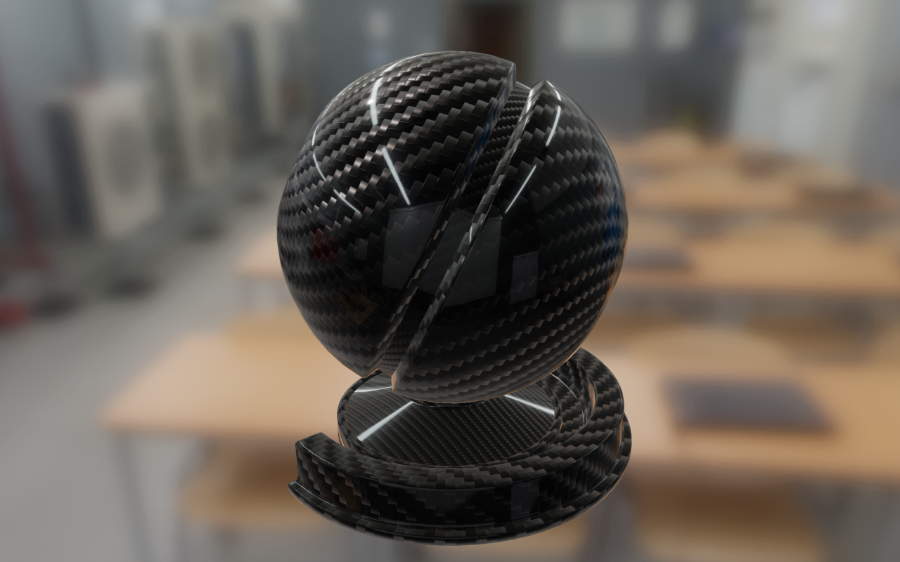Filament is a real-time physically based rendering engine for Android, Linux, macOS and Windows. This rendering engine was designed to be as small as possible and as efficient as possible on Android.
Filament is currently used in the Sceneform library both at runtime on Android devices and as the renderer inside the Android Studio plugin.
- Filament, an in-depth explanation of real-time physically based rendering, the graphics capabilities and implementation of Filament. This document explains the math and reasoning behind most of our decisions. This document is a good introduction to PBR for graphics programmers.
- Materials, the full reference
documentation for our material system. This document explains our different material models, how
to use the material compiler
matcand how to write custom materials. - Material Properties, a reference sheet for the standard material model.
Here are a few sample materials rendered with Filament:
- Native C++ API for Android, Linux, macOS and Windows
- Java/JNI API for Android, Linux, macOS and Windows
- Python bindings
- OpenGL 4.1+ for Linux, macOS and Windows
- OpenGL ES 3.0+ for Android
- Vulkan 1.0 for Android, Linux, macOS (with MoltenVk) and Windows
- Clustered forward renderer
- Cook-Torrance microfacet specular BRDF
- Lambertian diffuse BRDF
- HDR/linear lighting
- Metallic workflow
- Clear coat
- Anisotropic lighting
- Approximated translucent (subsurface) materials (direct and indirect lighting)
- Cloth shading
- Normal mapping & ambient occlusion mapping
- Image-based lighting
- Physically-based camera (shutter speed, sensitivity and aperture)
- Physical light units
- Point light, spot light and directional light
- ACES-like tone-mapping
- Temporal dithering
- FXAA or MSAA
- Dynamic resolution (on Android)
Many other features have been either prototyped or planned:
- IES light profiles
- Area lights
- Fog
- Color grading
- Bloom
- TAA
- etc.
filament: Filament engine and its supporting libraries and toolsandroid: Android libraries and projectsart: Source for various artworks (logos, PDF manuals, etc.)assets: 3D assets to use with sample applicationsbuild: CMake build scriptsdocs: Documentationmath: Mathematica notebooks used to explore BRDFs, equations, etc.
filament: Filament engineide: Configuration files for IDEs (CLion, etc.)java: Java bindings for Filament librarieslibs: Librariesbluegl: OpenGL bindings for macOS, Linux and Windowsbluevk: Vulkan bindings for macOS, Linux, Windows and Androidfilabridge: Library shared by the Filament engine and host toolsfilaflat: Serialization/deserialization library used for materialsfilagui: Helper library for Dear ImGuifilamat: Material generation libraryimage: Image filtering and simple transformsimageio: Image file reading / writing, only intended for internal usemath: Math libraryutils: Utility library (threads, memory, data structures, etc.)
samples: Sample desktop applicationsshaders: Shaders used byfilamatandmatcthird_party: External libraries and assetstools: Host toolscmgen: Image-based lighting asset generatorfilamesh: Mesh convertermatc: Material compilermatinfoDisplays information about materials compiled withmatcnormal-blending: Tool to blend normal mapsroughness-prefilter: Pre-filters a roughness map from a normal map to reduce aliasingskygen: Physically-based sky environment texture generatorspecular-color: Computes the specular color of conductors based on spectral data
To build Filament, you must first install the following tools:
- CMake 3.4 (or more recent)
- clang 5.0 (or more recent)
- ninja 1.8 (or more recent)
To build the Java based components of the project you can optionally install (recommended):
- OpenJDK 1.8 (or more recent)
Additional dependencies may be required for your operating system. Please refer to the appropriate section below.
To build Filament for Android you must also install the following:
- Android Studio 3.1
- Android SDK
- Android NDK
Make sure the environment variable ANDROID_HOME points to the location of your Android SDK.
By default our build system will attempt to compile the Java bindings. To do so, the environment
variable JAVA_HOME should point to the location of your JDK.
We recommend using CLion to develop for Filament. Simply open the root directory's CMakeList.txt in CLion to obtain a usable project.
Once the required OS specific dependencies listed below are installed, you can use the script
located in build.sh to build Filament easily on macOS and Linux.
This script can be invoked from anywhere and will produce build artifacts in the out/ directory
inside the Filament source tree.
To trigger an incremental debug build:
$ ./build.sh debug
To trigger an incremental release build:
$ ./build.sh release
To trigger both incremental debug and release builds:
$ ./build.sh debug release
To install the libraries and executables in out/debug/ and out/release/, add the -i flag.
You can force a clean build by adding the -c flag. The script offers more features described
by executing build.sh -h.
By default our build system will attempt to compile the Java bindings. If you wish to skip this
compilation step simply pass the -j flag to build.sh:
$ ./build.sh -j release
If you use CMake directly instead of the build script, pass -DENABLE_JAVA=OFF to CMake instead.
Make sure you've installed the following dependencies:
libglu1-mesa-devlibc++-dev(libcxx-develon Fedora)libc++abi-devninja-build
In addition your distribution might require:
libxi-dev
Then invoke cmake:
$ mkdir out/cmake-release
$ cd out/cmake-release
$ cmake -G Ninja -DCMAKE_BUILD_TYPE=Release -DCMAKE_INSTALL_PREFIX=../release/filament ../..
If you experience link errors you must ensure that you are using libc++abi by passing this
extra parameter to cmake:
-DFILAMENT_REQUIRES_CXXABI=true
Your Linux distribution might default to gcc instead of clang, if that's the case invoke
cmake with the following command:
$ mkdir out/cmake-release
$ cd out/cmake-release
# Or use a specific version of clang, for instance /usr/bin/clang-5.0
$ CC=/usr/bin/clang CXX=/usr/bin/clang++ \
cmake -G Ninja -DCMAKE_BUILD_TYPE=Release -DCMAKE_INSTALL_PREFIX=../release/filament ../..
You can also export the CC and CXX environment variables to always point to clang. Another
solution is to use update-alternatives to both change the default compiler, and point to a
specific version of clang:
$ update-alternatives --install /usr/bin/cc cc /usr/bin/clang 100
$ update-alternatives --install /usr/bin/c++ c++ /usr/bin/clang++ 100
$ update-alternatives --install /usr/bin/clang clang /usr/bin/clang-5.0 100
$ update-alternatives --install /usr/bin/clang++ clang++ /usr/bin/clang++-5.0 100
Finally, invoke ninja:
$ ninja
This will build Filament, its tests and samples, and various host tools.
To compile Filament you must have the most recent version of Xcode installed and you need to make sure the command line tools are setup by running:
$ xcode-select --install
After installing Java 1.8 you must also ensure that your JAVA_HOME environment variable is
properly set. If it doesn't already point to the appropriate JDK, you can simply add the following
to your .profile:
export JAVA_HOME="$(/usr/libexec/java_home)"
Then run cmake and ninja to trigger a build:
$ mkdir out/cmake-release
$ cd out/cmake-release
$ cmake -G Ninja -DCMAKE_BUILD_TYPE=Release -DCMAKE_INSTALL_PREFIX=../release/filament ../..
$ ninja
The following instructions have been tested on a machine running Windows 10. They should take you from a machine with only the operating system to a machine able to build and run Filament.
Google employees require additional steps which can be found here go/filawin.
Install the following components:
Open an VS2015 x64 Native Tools terminal (click the start button, type "x64 native tools" and select: "VS2015 x64 Native Tools Command Prompt").
Create a working directory:
> mkdir out/cmake-release
> cd out/cmake-release
Create the msBuild project:
> cmake -T"LLVM-vs2014" -G "Visual Studio 14 2015 Win64" ../..
Check out the output and make sure Clang for Windows frontend was found. You should see a line showing the following ouput.
Clang:C:/Program Files/LLVM/msbuild-bin/cl.exe
You are now ready to build:
> msbuild TNT.sln /t:material_sandbox /m /p:configuration=Debug
Run it:
> samples\material_sandbox.exe ..\..\assets\models\monkey\monkey.obj
- To troubleshoot an issue, use verbose mode via
/v:dflag. - To build a specific project, use
/t:NAMEflag (e.g:/t:material_sandbox). - To build using more than one core, use parallel build flag:
/m. - To build a specific profile, used
/p:configuration=(e.g:/p:configuration=Debug,/p:configuration=Release, and/p:configuration=RelWithDebInfo). - The msBuild project is what is used by Visual Studio behind the scene to build. Building from VS or from the command-line is the same thing.
Alternatively, you can use Ninja to build for Windows. An MSVC installation is still necessary.
First, install the dependencies listed under Windows as well as Ninja. Then open up a VS2015 x64 Native Tools terminal as before. Create a build directory inside Filament and run the following CMake command:
cmake .. -G Ninja ^
-DCMAKE_CXX_COMPILER:PATH="C:\Program Files\LLVM\bin\clang-cl.exe" ^
-DCMAKE_C_COMPILER:PATH="C:\Program Files\LLVM\bin\clang-cl.exe" ^
-DCMAKE_LINKER:PATH="C:\Program Files\LLVM\bin\lld-link.exe" ^
-DCMAKE_BUILD_TYPE=Release
You should then be able to build by invoking Ninja:
ninja
- Before shipping a binary, make sure you used Release profile and make sure you have no libc/libc++ dependencies with Dependency Walker.
- Application Verifier and gflags.exe can be of great help to trackdown heap corruption. Application
Verifier is easy to setup with a GUI. For gflags, use:
gflags /p /enable pheap-buggy.exe.
To confirm Filament was properly built, run the following command from the build directory:
./samples/material_sandbox --ibl=../../samples/envs/office ../../assets/models/sphere/sphere.obj
Before building Filament for Android, make sure to build Filament for your host. Some of the host tools are required to successfully build for Android.
Filament can be built for the following architectures:
- ARM 64-bit (
arm64-v8a) - ARM 32-bit (
armeabi-v7a) - Intel 64-bit (
x86_64) - Intel 32-bit (
x86)
Note that the main target is the ARM 64-bit target. Our implementation is optimized first and
foremost for arm64-v8a.
The easiest way to build Filament for Android is to use build.sh and the
-p android flag. For instance to build the release target:
$ ./build.sh -p android release
Run build.sh -h for more information.
$ $SDK/ndk-bundle/build/tools/make_standalone_toolchain.py --arch arm64 --api 24 \
--stl libc++ --force \
--install-dir toolchains/Linux/aarch64-linux-android-4.9
$ $SDK/ndk-bundle/build/tools/make_standalone_toolchain.py --arch arm64 --api 24 \
--stl libc++ --force \
--install-dir toolchains/Darwin/aarch64-linux-android-4.9
Then invoke CMake in a build directory of your choice, inside of filament's directory:
$ mkdir out/android-build-release-aarch64
$ cd out/android-build-release-aarch64
$ cmake -G Ninja -DCMAKE_TOOLCHAIN_FILE=../../build/toolchain-aarch64-linux-android.cmake \
-DCMAKE_BUILD_TYPE=Release -DCMAKE_INSTALL_PREFIX=../android-release/filament ../..
And then invoke ninja:
$ ninja install
or
$ ninja install/strip
This will generate Filament's Android binaries in out/android-release. This location is important
to build the Android Studio projects located in filament/android. After install, the library
binaries should be found in out/android-release/filament/lib/arm64-v8a.
$ $SDK/ndk-bundle/build/tools/make_standalone_toolchain.py --arch arm --api 24 \
--stl libc++ --force \
--install-dir toolchains/Linux/arm-linux-androideabi-4.9
$ $SDK/ndk-bundle/build/tools/make_standalone_toolchain.py --arch arm --api 24 \
--stl libc++ --force \
--install-dir toolchains/Darwin/arm-linux-androideabi-4.9
Then invoke CMake in a build directory of your choice, inside of filament's directory:
$ mkdir out/android-build-release-arm
$ cd out/android-build-release-arm
$ cmake -G Ninja -DCMAKE_TOOLCHAIN_FILE=../../build/toolchain-arm7-linux-android.cmake \
-DCMAKE_BUILD_TYPE=Release -DCMAKE_INSTALL_PREFIX=../android-release/filament ../..
And then invoke ninja:
$ ninja install
or
$ ninja install/strip
This will generate Filament's Android binaries in out/android-release. This location is important
to build the Android Studio projects located in filament/android. After install, the library
binaries should be found in out/android-release/filament/lib/armeabi-v7a.
$ $SDK/ndk-bundle/build/tools/make_standalone_toolchain.py --arch x86_64 --api 24 \
--stl libc++ --force \
--install-dir toolchains/Linux/x86_64-linux-android-4.9
$ $SDK/ndk-bundle/build/tools/make_standalone_toolchain.py --arch x86_64 --api 24 \
--stl libc++ --force \
--install-dir toolchains/Darwin/x86_64-linux-android-4.9
Then invoke CMake in a build directory of your choice, sibling of filament's directory:
$ mkdir out/android-build-release-x86_64
$ cd out/android-build-release-x86_64
$ cmake -G Ninja -DCMAKE_TOOLCHAIN_FILE=../../filament/build/toolchain-x86_64-linux-android.cmake \
-DCMAKE_BUILD_TYPE=Release -DCMAKE_INSTALL_PREFIX=../out/android-release/filament ../..
And then invoke ninja:
$ ninja install
or
$ ninja install/strip
This will generate Filament's Android binaries in out/android-release. This location is important
to build the Android Studio projects located in filament/android. After install, the library
binaries should be found in out/android-release/filament/lib/x86_64.
$ $SDK/ndk-bundle/build/tools/make_standalone_toolchain.py --arch x86 --api 24 \
--stl libc++ --force \
--install-dir toolchains/Linux/i686-linux-android-4.9
$ $SDK/ndk-bundle/build/tools/make_standalone_toolchain.py --arch x86 --api 24 \
--stl libc++ --force \
--install-dir toolchains/Darwin/i686-linux-android-4.9
Then invoke CMake in a build directory of your choice, sibling of filament's directory:
$ mkdir out/android-build-release-x86
$ cd out/android-build-release-x86
$ cmake -G Ninja -DCMAKE_TOOLCHAIN_FILE=../../filament/build/toolchain-x86-linux-android.cmake \
-DCMAKE_BUILD_TYPE=Release -DCMAKE_INSTALL_PREFIX=../out/android-release/filament ../..
And then invoke ninja:
$ ninja install
or
$ ninja install/strip
This will generate Filament's Android binaries in out/android-release. This location is important
to build the Android Studio projects located in filament/android. After install, the library
binaries should be found in out/android-release/filament/lib/x86.
Before you attempt to build the AAR, make sure you've compiled and installed the native libraries
as explained in the sections above. You must have the following ABIs built in
out/android-release/filament/lib/:
arm64-v8aarmeabi-v7ax86_64x86
To build Filament's AAR simply open the Android Studio project in android/filament-android. The
AAR is a universal AAR that contains all supported build targets:
arm64-v8aarmeabi-v7ax86_64x86
To filter out unneeded ABIs, rely on the abiFilters of the project that links against Filament's
AAR.
Alternatively you can build the AAR from the command line by executing the following the
android/filament-android directory:
$ ./gradlew -Pfilament_dist_dir=../../out/android-release/filament assembleRelease
The -Pfilament_dist_dir can be used to specify a different installation directory (it must match
the CMake install prefix used in the previous steps).
Create a new module in your project and select Import .JAR or .AAR Package when prompted. Make sure to add the newly created module as a dependency to your application.
If you do not wish to include all supported ABIs, make sure to create the appropriate flavors in your Gradle build file. For example:
flavorDimensions 'cpuArch'
productFlavors {
arm8 {
dimension 'cpuArch'
ndk {
abiFilters 'arm64-v8a'
}
}
arm7 {
dimension 'cpuArch'
ndk {
abiFilters 'armeabi-v7a'
}
}
x86_64 {
dimension 'cpuArch'
ndk {
abiFilters 'x86_64'
}
}
x86 {
dimension 'cpuArch'
ndk {
abiFilters 'x86'
}
}
universal {
dimension 'cpuArch'
}
}
The samples/ directory contains several examples of how to use Filament with SDL2.
Some of the samples accept FBX/OBJ meshes while others rely on the filamesh file format. To
generate a filamesh file from an FBX/OBJ asset, run the filamesh tool
(./tools/filamesh/filamesh in your build directory):
filamesh ./assets/models/monkey/monkey.obj monkey.filamesh
Most samples accept an IBL that must be generated using the cmgen tool (./tools/filamesh/cmgen
in your build directory). These sample apps expect a path to a directory containing the RGBM files
for the IBL. To generate an IBL simply use this command:
cmgen -x ./ibls/ my_ibl.exr
The source environment map can be a PNG (8 or 16 bit), a PSD (16 or 32 bit), an HDR or an OpenEXR file. The environment map can be an equirectangular projection, a horizontal cross, a vertical cross, or a list of cubemap faces (horizontal or vertical).
cmgen will automatically create a directory based on the name of the source environment map. In
the example above, the final directory will be ./ibls/my_ibl/. This directory should contain the
pre-filtered environment map (one file per cubemap face and per mip level), the environment map
texture for the skybox and a text file containing the spherical harmonics for indirect diffuse
lighting.
If you prefer a blurred background, run cmgen with this flag: --extract-blur=0.5. The numerical
value is the desired roughness between 0 and 1.
You must create an Engine, a Renderer and a SwapChain. The SwapChain is created from a
native window pointer (an NSView on macOS or a HDC on Windows for instance):
Engine* engine = Engine::create();
SwapChain* swapChain = engine->createSwapChain(nativeWindow);
Renderer* renderer = engine->createRenderer();To render a frame you must then create a View, a Scene and a Camera:
Camera* camera = engine->createCamera();
View* view = engine->createView();
Scene* scene = engine->createScene();
view->setCamera(camera);
view->setScene(scene);Renderables are added to the scene:
Entity renderable = EntityManager::get().create();
// build a quad
RenderableManager::Builder(1)
.boundingBox({{ -1, -1, -1 }, { 1, 1, 1 }})
.material(0, materialInstance)
.geometry(0, RenderableManager::PrimitiveType::TRIANGLES, vertexBuffer, indexBuffer, 0, 6)
.culling(false)
.build(*engine, renderable);
scene->addEntity(renderable);The material instance is obtained from a material, itself loaded from a binary blob generated
by matc:
Material* material = Material::Builder()
.package((void*) BAKED_MATERIAL_PACKAGE, sizeof(BAKED_MATERIAL_PACKAGE))
.build(*engine);
MaterialInstance* materialInstance = material->createInstance();To learn more about materials and matc, please refer to the
materials documentation.
To render, simply pass the View to the Renderer:
// beginFrame() returns false if we need to skip a frame
if (renderer->beginFrame(swapChain)) {
// for each View
renderer->render(view);
renderer->endFrame();
}For complete examples of Linux, macOS and Windows Filament applications, look at the source files
in the samples/ directory. These samples are all based on samples/app/ which contains the code
that creates a native window with SDL2 and initializes the Filament engine, renderer and views.
After building Filament, you can use filament-java.jar and its companion filament-jni native
library to use Filament in desktop Java applications. You can use Filament either with AWT or
Swing, using respectively a FilamentCanvas or a FilamentPanel.
Following the steps above (how to use Filament from native code), create an Engine and a
Renderer, but instead of calling beginFrame and endFrame on the renderer itself, call
these methods on FilamentCanvas or FilamentPanel.
Rendering with Filament on Android is similar to rendering from native code (the APIs are largely
the same across languages). You can render into a Surface by passing a Surface to the
createSwapChain method. This allows you to render to a SurfaceTexture, a TextureView or
a SurfaceView. To make things easier we provide an Android specific API called UiHelper in the
package com.google.android.filament.android. All you need to do is set a render callback on the
helper and attach your SurfaceView or TextureView to it. You are still responsible for
creating the swap chain in the onNativeWindowChanged() callback.
To generate the documentation you must first install doxygen, then run the following commands:
$ cd filament/filament
$ doxygen docs/doxygen/filament.doxygen
Finally simply open docs/html/index.html in your web browser.
One of our design goals is that Filament itself should have no dependencies or as few dependencies as possible. The current external dependencies of the runtime library include:
- STL
- robin-map (header only library)
Host tools (such as matc or cmgen) can use external dependencies freely.
Please read and follow the steps in CONTRIBUTING.md. Make sure you are familiar with the code style.
Please see LICENSE.
This is not an officially supported Google product.





